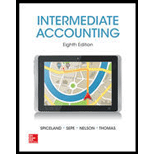
Error correction:
Error correction is an adjustment to previously issued financial statements. It is not considered as an accounting change.
To Journalize: Entry necessary to correct the error, and
Explanation of Solution
| Date | Account Title and Explanation | Debit Amount($) | Credit Amount($) |
| 61,000 | |||
| Interest expense (1) | 61,000 | ||
| (To record error found before adjustment) |
Table (1)
- Retained earnings are component of shareholders’ equity. There is a decrease in the value of shareholders’ equity. Therefore, it is debited.
- Interest expense is a liability. There is an increase in liability value. Therefore, it is credited.
Adjusting entry for the year 2016
| Date | Account Title and Explanation | Debit Amount($) | Credit Amount($) |
| Interest expense (1) | 61,000 | ||
| Discount on bonds payable(2) | 1,000 | ||
| Interest payable(3) | 60,000 | ||
| (To record error discovered before adjustment) |
Table (2)
- Interest expense is a liability. There is a decrease in liability value. Therefore, it is debited.
- Discount on bonds payable and notes payable are liability. There is an increase in liability value. Therefore, it is credited.
- Interest payable is a liability which is increased; hence credit the interest payable.
Journal entries that should have been recorded:
Adjusting entry for the year 2015
| Date | Account Title and Explanation | Debit Amount($) | Credit Amount($) |
| Interest expense(1) | 61,000 | ||
| Discount on bonds payable(2) | 1,000 | ||
| Interest payable(3) | 60,000 | ||
| (To record error discovered before adjustment) |
Table (3)
- Interest expense is a liability. There is a decrease in liability value. Therefore, it is debited.
- Discount on bonds payable and notes payable are liability. There is an increase in liability value. Therefore, it is credited.
- Interest payable is a liability which is increased; hence credit the interest payable.
Journal Entry for the year 2016
|
Date |
Account Title and Explanation | Debit Amount($) | Credit Amount($) |
| Interest expense(4) | 12,200 | ||
| Interest payable(3) | 60,000 | ||
| Discount on bonds payable(5) | 200 | ||
| Cash(Given) | 72,000 | ||
| (To record the correct entry) |
Table (4)
- Interest expense is a liability. There is a decrease in liability value. Therefore, it is debited.
- Interest payable is a liability which is decreased; hence debit the interest payable.
- Discount on bonds payable is a liability which is increased; hence credit the discount on bonds payable.
- Cash is being paid, cash is an asset which is being decreased; hence credit the cash account.
Working notes:
a. Calculate the interest expense for the year 2015
Interest expense=Cash×(Number of months completedInterest period )=$72,000×(5months6 months)=$72,000×0.833333=$61,000. (1)
b. Calculate discount on bonds payable for the year 2015
(Discount on bondafter correction)=(Discount on bondbefore correction)×(Number of months completedinterest payable)=$1,200×(5 months6 months)=$1,200×0.833333=$1,000. (2)
c. Calculate the interest payable for both the years of 2015 and 2016
Interest payable=cash×(Number of months completedInterest period)=$72,000×(5 months6 months)= $72,000×0.833333=$60,000. (3)
d. Calculate the interest expense for the year 2016 up to February 1.
(Interest expenseafter correction)=(Interest expense before correction)×(Number of months completedInterest period )=$73,200×(1 month6 months)=$73,200×0.16666=$12,200. (4)
e. Calculate the discount on bonds payable for the year 2016 up to February 1.
(Discount on bondafter correction)=(Discount on bondbefore correction)×(Number of months completedinterest period)=$1,200×(1 month6 months)=$1,200×0.16666=$200. (5)
Interest expenses of 2016 are overstated by recording extra interest in the month of February. Likewise, retained earnings are overstated by the exact amount as the interest expense of 2015 was understated when the accrued interest was not reported.
Want to see more full solutions like this?
Chapter 20 Solutions
INTERMEDIATE ACCOUNTING
- Summarize what each value of the balance sheet for Assets, Liabilities and Owner Equity represents to the company. For example, what does the Cash value of $8484 represents to the company.Why are all values important for the company and for the balance sheet.arrow_forwardCan you explain the steps for solving this financial accounting question accurately?arrow_forwardI am trying to find the accurate solution to this general accounting problem with the correct explanation.arrow_forward

 AccountingAccountingISBN:9781337272094Author:WARREN, Carl S., Reeve, James M., Duchac, Jonathan E.Publisher:Cengage Learning,
AccountingAccountingISBN:9781337272094Author:WARREN, Carl S., Reeve, James M., Duchac, Jonathan E.Publisher:Cengage Learning, Accounting Information SystemsAccountingISBN:9781337619202Author:Hall, James A.Publisher:Cengage Learning,
Accounting Information SystemsAccountingISBN:9781337619202Author:Hall, James A.Publisher:Cengage Learning, Horngren's Cost Accounting: A Managerial Emphasis...AccountingISBN:9780134475585Author:Srikant M. Datar, Madhav V. RajanPublisher:PEARSON
Horngren's Cost Accounting: A Managerial Emphasis...AccountingISBN:9780134475585Author:Srikant M. Datar, Madhav V. RajanPublisher:PEARSON Intermediate AccountingAccountingISBN:9781259722660Author:J. David Spiceland, Mark W. Nelson, Wayne M ThomasPublisher:McGraw-Hill Education
Intermediate AccountingAccountingISBN:9781259722660Author:J. David Spiceland, Mark W. Nelson, Wayne M ThomasPublisher:McGraw-Hill Education Financial and Managerial AccountingAccountingISBN:9781259726705Author:John J Wild, Ken W. Shaw, Barbara Chiappetta Fundamental Accounting PrinciplesPublisher:McGraw-Hill Education
Financial and Managerial AccountingAccountingISBN:9781259726705Author:John J Wild, Ken W. Shaw, Barbara Chiappetta Fundamental Accounting PrinciplesPublisher:McGraw-Hill Education





